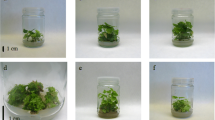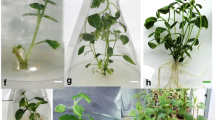Abstract
A suitable protocol for micropropagation of Casuarina hybrid, Casuarina equisetifolia L. × Casuarina glauca Sieber ex Spreng (C. e. × C. g.), was developed. When seeds without seed coats were cultured on 4 germination media, the optimal seed germination percentage (91%) was obtained on 0.8% agar solidified water medium. Shoot multiplication was achieved by culturing 2-cm long epicotyls, excised from germinated seedlings, on MS (Murashige and Skoog 1962) basal medium supplemented with BA (6-benzylaminopurine) at 4.4, 8.8, 17.8 and 35.6 μM. The greatest percentage of axillary bud sproutings (87.5%), mean number of sprouts per explant (3.8), and shoot length (3.2 cm) were achieved on MS medium supplemented with 17.8 μM BA. MS medium supplemented with 4 different concentrations of IBA (indole-3-butyric acid) (4.3, 8.7, 13.0 and 17.4 μM) were used for rooting of in vitro grown shoots. The highest rooting percentage (65.6%), mean number of roots per explant (2.5) and mean length of roots per explant (1.6 cm) was achieved at 13.0 μM IBA. Rooted shoots grew well after transfer to a substrate of peat and pinebark (7:3) in the greenhouse.



Similar content being viewed by others
Abbreviations
- BA:
-
6-Benzylaminopurine
- C. e. × C. g. :
-
Casuarina equisetifolia L. × Casuarina glauca Sieber ex Spreng
- IBA:
-
Indole-3-butyric acid
- MS:
-
Murashige and Skoog (1962)
- PGRs:
-
Plant growth regulators
References
Abdullah AA, Grace J, Yeoman NM (1989) Rooting and establishment of calabrian pine plantlets propagated in vitro: influence of growth substance, rooting medium and origin of explant. New Phytol 113:193–202. doi:10.1111/j.1469-8137.1989.tb04706.x
Beadle NCW (1981) The vegetation of Australia. Cambridge University Press, Cambridge
Boland DJ, Moncur MW, Pinyopusarerk K (1996) Review of some floral and vegetative aspects to consider when domesticating Casuarina. In: Pinyopusarerk K, Turnbull JW, Midgley SJ (eds) Recent Casuarina Research and Development, Proceedings of the Third International Casuarina Workshop, Da Nang, Vietnam, 4–7 March 1996, pp 17–25
Castle WS (2007) Windbreaks for citrus. University of Florida website at http://www.crec.ifas.ufl.edu/extension/windbreaks
Castle WS (2008a) Casuarina cunninghamiana Miq. (River sheoak) in Florida and its potential as a windbreak plant for citrus groves. HS 1139, Florida Cooperative Extension Service, Institute of Food and Agricultural Sciences, University of Florida
Castle WS (2008b) Field guide to identify the common Casuarina (Australian pine) species in Florida. HS 1140, Florida Cooperative Extension Service, Institute of Food and Agricultural Sciences, University of Florida
De Klerk GJ (2002) Rooting of microcuttings: theory and practice. In Vitro Cell Dev Biol Plant 38:415–422
De Klerk GJ, Brugge TJ, Marinova S (1997) Effectiveness of indoleacetic acid, indolebutyci acid and naphthaleneacetic acid during adventitious root formation in vitro in Malus ‘Jork 9’. Plant Cell Tissue Organ Cult 49:39–44. doi:10.1023/A:1005850222973
Duhoux E, Sougoufara B, Dommergues Y (1986) Propagation of Casuarina equisetifolia through axillary buds of immature female inflorescences cultured in vitro. Plant Cell Rep 3:161–164. doi:10.1007/BF00269108
El-Lakany MH (1983a) A review of breeding drought resistant Casuarina for shelterbelt establishment in arid regions with special reference to Egypt. For Ecol Manage 6:129–137. doi:10.1016/0378-1127(83)90017-8
El-Lakany MH (1983b) Breeding and improving Casuarina: a promising multipurpose tree for arid regions of Egypt. In: Midgley SJ, Turnbull JW, Johnston RD (eds) Casuarina ecology, management and utilization. CSIRO, Melbourne, pp 58–65
El-Lakany MH, Shepherd KR (1983) Variation in seed germinability, seedling growth, and biomass between provenances of Casuarina cumminghamiana Miq. and C. glauca Siev. For Manage Ecol 6:201–216. doi:10.1016/S0378-1127(83)80003-6
El-Lakany MH, Omran TA, Shehata MS (1989) Variation in seed characteristics of Casuarina as affected by species, season of collection and positions on the tree crown. Int Tree Crops J 5:237–245
Fay MF (1991) Conservation of rare and endangered plants using in vitro methods. In Vitro Cell Dev Biol Plant 28:1–4
Fay MF (1992) In what situations is in vitro culture appropriate to plant conservations? Biodivers Conserv 3:176–183. doi:10.1007/BF02291887
Gaspar T, Kevers C, Penel C, Greppin H, Reid DM, Thorpe TA (1996) Plant hormones and plant growth regulators in plant tissue culture. In Vitro Cell Dev Biol Plant 32:272–289. doi:10.1007/BF02822700
Gavidia I, Perez-Bermudez P, Segura J (1996) Micropropagation of bay laurel (Dephne gnidium L.). J Hortic Sci 71:977–983
Goh CJ, Lakshmanan P, Lee CL, Loh CS, Tanaka M (1995) A simple and efficient method for clonal propagation of Casuarina sumatrana (de Vriese) L. Johnson. Plant Growth Regul 17:115–120. doi:10.1007/BF00024170
Hartmann HT, Kester DE, Davies FT (1990) Plant propagation principles and practices. Prentice Hall, Englewood Cliffs, NJ
Jerlin R, Srimathi P (1997) Grading and storage potential of Casuarina equisetifolia seeds. Ann For Sci 5:103–106
Kang L (1996) Effects of Frankia inoculation and nutrient application on seedling growth of Casuarina species. In: Pinyopusarerk K, Turnbull JW, Midgley SJ (eds) Recent Casuarina Research and Development Proceedings of the Third International Casuarina Workshop, Da Nang, Vietnam, 4–7 March 1996, pp 59–62
Kondas S (1983) Casuarina equisetifolia—a multipurpose tree cash crop in India. In: Midgley SJ, Turnbull YW, Johnson RD (eds) Casuarina Ecology, Management and Utilization. CSIRO, Australia, pp 66–67
Mark GL, Hooker JE, Hahn A, Wheeler CT (1998) In vitro culture of arbuscular mycorrhizal fungus and Frankia for inoculation of micropropagated Casuarina equisetifolia L. Can J Bot 77:1391–1397
Midgley SJ, Turnbull JW, Johnston RD (eds) (1983) Casuarina ecology, management and utilization. CSIRO, Melbourne, p 286
Murashige T (1974) Plant propagation through tissue culture. Ann Rev Plant Physiol 25:135–166
National Academy of Science (1984) Casuarina: nitrogen-fixing trees for adverse sites. National Academy of Science, Washington, p 118
Noiton D, Vine JH, Mullins MG (1992) Endogenous indole-3-acetic acid and abscisic acid in apple microcuttings in relation to adventitious root formation. Plant Growth Regul 11:63–67
Parthiban KT, Narayanan R, Rai RSV, Surendran C, Ravichandran VK (1997) Callogenesis and organogenesis in Casuarina equisetifolia F. R. & G. Forst. Indian J For 20:227–230
Pruski K, Nowak J, Grainger G (2000) Micropropagation of four cultivars of Saskatoon berry (Amelanchier alnifolia Nutt.). Plant Cell Tissue Organ Cult 21:103–109
SAS Institute Inc (1999) Verdion 8.02. SAS Institute, Cary, NC
Seth R, Kendurkar S, Nadgauda R (2007) In vitro clonal propagation of Casuarina equisetifolia Forst. from mature tree-derived explants. Curr Sci 3:287–290
Sivakumar V, Anandalakshmi R, Warrier RR, Singh BG, Tigabu M, Oden PC (2007) Petroleum flotation technique upgrades the germinability of Casuarina equisetifolia seed lots. New For 34:281–291
Thorpe TA, Harry IS (1990) Special problems and prospects in the propagation of woody species. NATO ASI series: Series A: Life science (USA)
Turnbull JW (1990) Taxonomy and genetic variation in Casuarina. In: El-Lakany MH, Turnbull JW, Brewbaker JL (eds) Advances in Casuarina research and utilization. Proceedings of the Second International Casuarina Workshop, Desert Development Center, AUC, Cairo, pp 1–11
Turnbull JW, Martensz PN (1982) Seed production, collection and germination in Casuarinaceae. Aust For Res 12:281–294
Zimmerman RH (1988) Micropropagation of woody plants: post tissue culture aspects. Acta Hortic 227:489–499
Zimpfer JF, Igual JM, McCarty B, Smyth C, Dawson JO (2004) Casuarina cunninghamiana tissue extracts stimulate the growth of Frankia and differentially alter the growth of other soil microorganisms. J Chem Ecol 30:439–452
Author information
Authors and Affiliations
Corresponding author
Rights and permissions
About this article
Cite this article
Shen, X., Castle, W.S. & Gmitter, F.G. Micropropagation of a Casuarina hybrid (Casuarina equisetifolia L. × Casuarina glauca Sieber ex Spreng) following facilitated seed germination. Plant Cell Tiss Organ Cult 97, 103–108 (2009). https://doi.org/10.1007/s11240-009-9502-5
Received:
Accepted:
Published:
Issue Date:
DOI: https://doi.org/10.1007/s11240-009-9502-5




